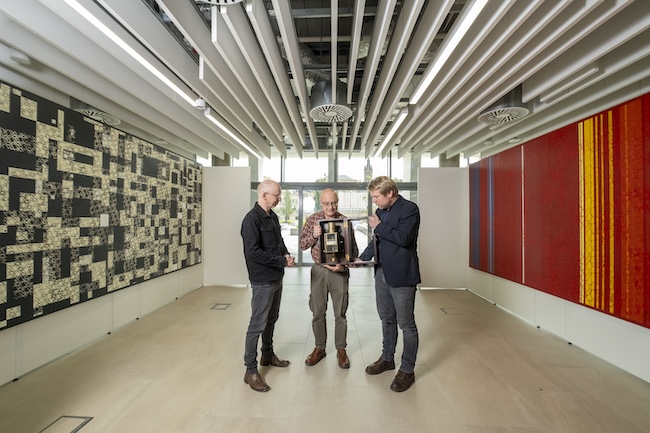University of Glasgow celebrates Lord Kelvin bicentenary
Published: 24 June 2024
The University of Glasgow is welcoming guests from around the world to celebrate the 200th anniversary of the birth of Lord Kelvin.
The University of Glasgow is welcoming guests from around the world to celebrate the 200th anniversary of the birth of Lord Kelvin.
He grew up to be one of the 19th century’s most accomplished scientists, making breakthrough contributions to physics, engineering and mathematics during his near-lifelong career at the University of Glasgow, where he enrolled as a student aged just 10.
Each event will cast new light on Kelvin’s life of invention, innovation and inspiration through expert lectures, the display of historical items and records, and artistic interpretation.

On June 25th, the Lord Kelvin: Beyond Absolute Zero exhibition will begin a two-week run at the University’s Mazumdar-Shaw Advanced Research Centre (ARC).
The exhibition will showcase historical items including an antique Kelvin-designed voltmeter, one of the commercial products he created following his development of accurate methods of measuring electricity. Through videos and text displays, visitors can learn about Kelvin’s life and work and some of his lesser-known achievements, including work on chirality, a key scientific concept of molecular symmetry with important applications in biology.
Kelvin’s mathematical formula for the most efficient space-filling shape, which remained unsurpassed until 1993, is part of the inspiration for two new paintings created by artist Gregor Harvie in collaboration with researchers from the University’s School of Physics & Astronomy. The large canvases – one filled with colour and one monochrome – depict the universes of light and dark matter, each depicting an intricate lattice of computer-modelled Kelvin cells inspired by Kelvin’s mathematical formula.
Gregor Harvie said: “There has always been a relationship between art and science. They draw on the same pool of cultural and environmental knowledge and have often explored similar ideas. Physics, like art, is a search for patterns – things that can be recognised and described.
“I’m delighted to be part of the University’s celebrations of Kelvin, and to have been doubly inspired both by his work and that of the researchers building on his insights 117 years after his death.”
Professor Stephen Barnett, of the University’s Quantum Theory Group, collaborated with Harvie on discussions about the theory behind the paintings for more than a year. He said: “Working with Gregor to produce these very striking paintings has been a fantastic experience, and I’m thrilled to see them on display at the University during our Kelvin bicentenary celebrations.
“Kelvin’s work across a wide range of disciplines helped in many ways to create the world we live in today. He made key contributions to laying the first transatlantic telegraph cable, leading directly to our ultra-connected world, and he was the first person to have his home lit entirely by electric light, showing the benefits of electricity. It’s wonderful to think that he’s continuing to provide inspiration not just for scientists but for artists too.”

Also on June 25th, Japanese physicist and Nobel laureate Professor Takaaki Kajita will deliver a public lecture on measuring neutrinos and gravitational waves following in the footsteps of Lord Kelvin, who pioneered precision measurements in areas including temperature. The Kelvin scale of of temperature he developed is based on his identification of absolute zero, where all atoms stop moving, at −273.15°C.
On June 26th, the ARC will host the Kelvin Bicentenary Symposium, featuring speakers from the UK and USA presenting talks on how Kelvin’s work on precision measurement, thermodynamics, optics and communications helped shape the modern world.
Later that day, The Hunterian will host Dr Daniel Mitchell of the IEEE History Centre for a lecture on Kelvin’s contributions to measurement and quantification, building on Kelvin’s famous dictum that ‘When you can measure what you are speaking about, and express it in numbers, you know something about it; but when you cannot measure it, when you cannot express it in numbers, your knowledge is of a meagre and unsatisfactory kind’.
A series of events between June 26th and July 9th will showcase Kelvin-related historical items curated by the University of Glasgow Library and The Hunterian. The two-part Collecting Kelvin events will allow visitors to Library and Kelvin Hall a rare opportunity to see some of Kelvin’s records, documents, prototypes and scientific instruments in the company for themselves.
Professor Sir Anton Muscatelli, principal and vice-chancellor of the University of Glasgow, said: “Lord Kelvin is one of the key figures of the 573-year history of the University of Glasgow, and we’re proud to be celebrating his legacy during this bicentenary year. A true polymath who made vital contributions to a range of scientific disciplines during his life, he was also a pioneering businessman whose inventions helped drive forward the burgeoning industrial revolution.
“Today, researchers across the University of Glasgow continue to draw inspiration from Kelvin’s life and work. We’re making breakthroughs in communications, precision measurement, low-carbon energy and more, building on the remarkable foundations he laid. We’re also inspired by Kelvin’s entrepreneurial spirit as we seek to translate our research into innovative solutions to global problems.
“We’re looking forward to welcoming guests, members of the public and colleagues from around the world onto campus during the week of the 200th anniversary of Kelvin’s birth to help us celebrate his achievements. We plan to announce further Kelvin-inspired events and activities as the year progresses.”
First published: 24 June 2024
<< June

